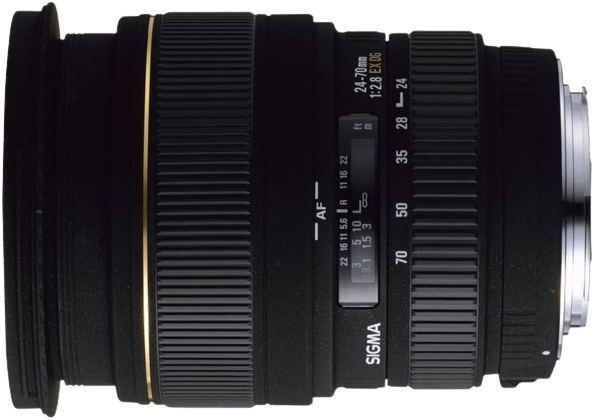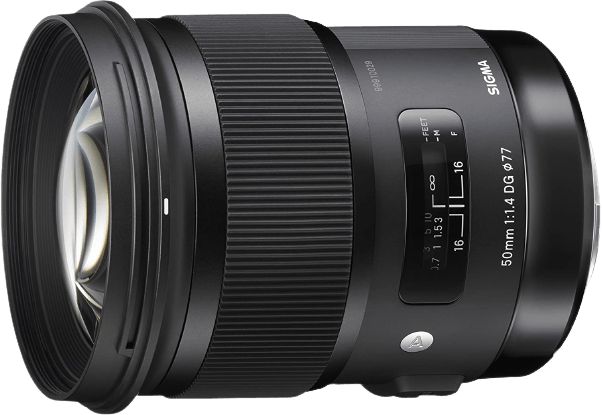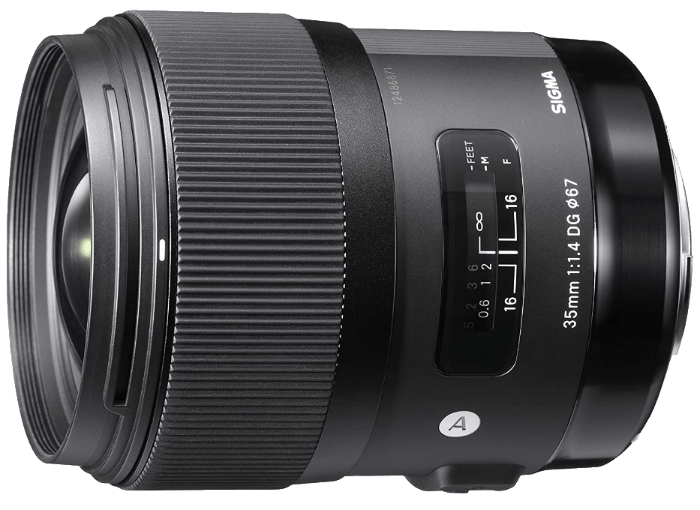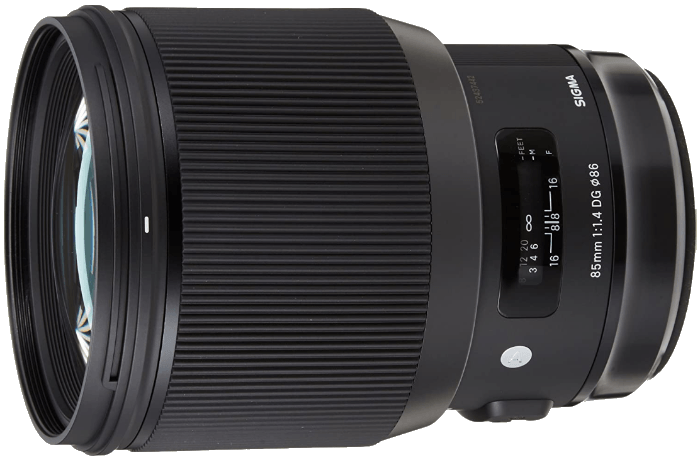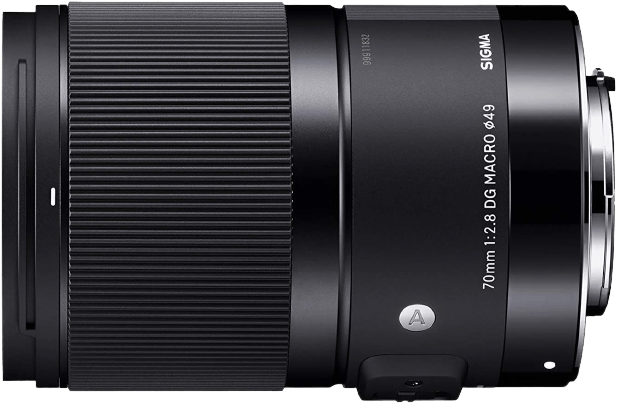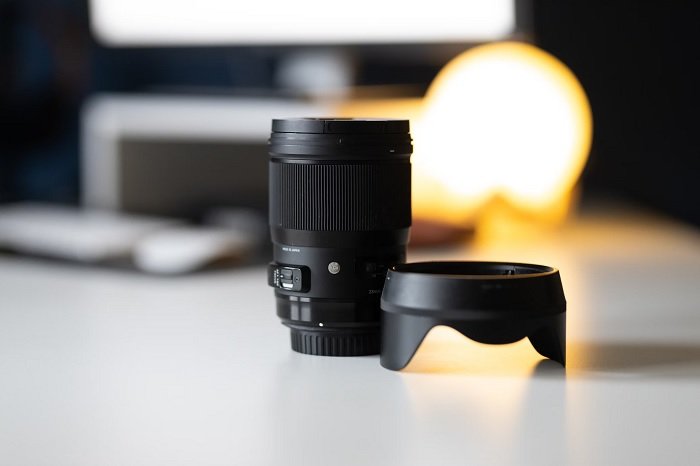The Sigma 24-70mm f/2.8 Art DG OS HSM is the best Sigma Art Lens, in our opinion. (It’s also available for Nikon, Sony, and other camera brands.) The optical quality is excellent. And it has a versatile zoom range. It’s equipped with image stabilization, good autofocus, and pristine glass. But if that’s not the Sigma Art Lens for you, check out the full list below.
Our Favorite Sigma Art Lenses
Sigma organizes its lenses into three distinct product lines—Art, Contemporary, and Sports. And each line has a distinct concept that sets the requirements for future lenses. The Sigma Art line was designed for optical performance and artistic expression. The lenses have wide apertures to let in lots of light. And Sigma crafts its Art lenses to maximize quality and visual effects. They want to achieve two things:
Soft focus with a shallow depth of field Sharp images with no distortion or aberration
The Sigma Art lenses are designed specifically for high-resolution cameras. They work with the camera to make the most of a high pixel count. The Art line is about optimizing quality. So Sigma Art lenses are for photographers who appreciate the image. The Art line includes a wide range of lenses. It has prime and zoom lenses. And it also features wide-angle and standard-view lenses. You need to go to the Contemporary and Sports lines for telephoto lenses. Here’s a sneak-peak of the best Sigma Art Lenses so you can see which might suit you best. In the next section, we’ll look at each Sigma Art lens.
The 7 Best Sigma Art Lenses in Detail
These are our favorite lenses from the Sigma Art series. They’ve produced some cracking lenses over the last couple of years. And these are the top picks from the current Art range. We’ve included lenses to suit different types of photography. The prices might be higher than you’re used to seeing with Sigma. But the quality is there to back it up. And if you’re new to Sigma, the Art series is a great place to start. We link to Canon versions in the title and all lens versions at the end of each entry. The Sigma 24-70mm f/2.8 Art DG OS HSM lens is the ultimate all-rounder. It meets nearly any photography brief. And you can set off on photography trips with minimal equipment. The optical quality is excellent. And the results surpass other third-party lenses in this category. It won’t be long until it’s your go-to Sigma lens. This is one of the pricier Sigma lenses on the list. But the quality and features give you the extra value for money you expect from Sigma. The lens has a rugged construction. The center is a metal barrel. And the mount has a rubber seal that’s dustproof and splashproof. The optical quality is fantastic throughout the zoom range. The 19 glass elements see to that. They include three Special Low Dispersion (SLD) elements. And those are partnered with four aspherical glass elements. It’s precision engineering. This Sigma lens is wide enough for landscapes and architecture shots. It has a good focal range for portrait and fine art photography. Street photographers will love it, I’m sure. And the larger focal length allows you to shoot events, nature, and sports photography. The focus ring has a smooth twist action. It gives you excellent manual focus control. And the HSM AF motor is reliable. “HSM” identifies the fast and quiet Hyper Sonic Motor for outstanding autofocus performance. And The Sigma 24-70mm f/2.8 Art DG OS HSM, unlike previous lenses, has optical stabilization. That’s a beneficial feature for many photographers for three reasons:
It reduces camera shake, which can be an issue working at the largest focal length. It gives you more freedom within your aperture range. It gives you more shutter speed options.
It doesn’t have the biggest max aperture. But a wide stop of f/2.8 allows enough light for low-light situations. Plus, you get a beautiful bokeh effect. The 9-blade aperture ring also adds richness to the areas of soft focus. You can shoot fabulous portraits and products with this lens. It’s the ultimate all-round Sigma lens. The Sigma 24-70mm f/2.8 Art DG OS HSM is available for Sony, Nikon, and Canon cameras. Some might be surprised to see us open our list with a prime lens. But the Sigma 50mm F1.4 Ar DG HSM lens is a fantastic piece of equipment. The 50mm focal length makes it a versatile lens. Street photographers will love it. And 50mm is fantastic for landscapes and portraits. It works well outdoors and in the studio. And it’s perfect for travel photography and photojournalism. It’s the best Sigma art lens if you want an all-rounder. The build quality is fantastic. The lens has 13 glass elements in 8 groups. The optical quality of the glass is very high. And Sigma has used special low-dispersion glass. And the outer elements have Sigma’s Super Multi-Layer Coating. These combine to reduce glare and chromatic aberration. You can expect crisp and clear photos from every shot. This 50mm Sigma Art lens uses a Hyper Sonic Motor (HSM) to power the autofocus. It’s fast with a smooth operation. And the Sigma HSM is also quiet when focusing. That’s ideal for photographers who want to keep a low profile. The Sigma 50mm f/1.4 Art DG HSM lens has incredible sharpness. It’s especially true when using the lens at the widest aperture. It’s not a macro lens. But with a minimum focus distance of 15″ (40 cm), you can shoot close-up photographs. Product photographers will be happy with that. One of its top selling points is the max aperture. You get a wide aperture of f/1.4, giving you plenty of natural light. That opens up more options with ISO and shutter speed. And it allows you to achieve a beautiful bokeh effect. That’s something portrait, and product photographers will love. We’re disappointed not to see image stabilization in this lens. And it isn’t fully weather sealed, so you need to be careful shooting outside. But these are only two issues in an otherwise superb lens. The 50mm f/1.4 Art DG HSM lens is available for Canon, Nikon, and Sony camera bodies. Make sure you buy one that’s compatible. The third entry on our list is a fantastic wide-angle zoom lens. It’s a well-made piece of kit, meeting the needs of many types of photographers. The images taken with the Sigma 18-35mm f/1.8 Art DC HSM lens are bright and brilliant. And it’s an affordable and lightweight option at 1.79 lb (811 g). The 18-35mm focal range gives you an excellent field of view. At 18mm, you get a fantastic wide-angle shot. And you can adjust it to 35mm for a more standard view. It isn’t the largest focal range for a zoom lens. But it serves a lot of photographers. It gives you stunning landscape photos. And you can use it for studio and environmental portraits. Plus, this lens was also designed with video in mind. The wide angle is perfect for sweeping shots and music videos. But real-estate photographers will be the most excited about this lens. The range is ideal for interior and exterior architecture shots. You don’t have to change the lens for every property shot. Wide-angle lenses can be prone to aberration and distortion. But the build quality of the 18-35mm f/1.8 Art DC HSM lens sets that straight. There are 17 elements in 12 groups. And these include five low-dispersion and four aspherical elements. The low-dispersion glass reduces aberration to a minimum. The manual focus ring is another positive. It gives a smooth motion and accurate control. And the lens body is made of a thermally stable composite material. So it’s another lightweight option. This Sigma Art lens isn’t perfect. We’re disappointed there’s no image stabilization. Although, that is less important with wide angles. And the lack of weather sealing isn’t ideal for outdoor photography. But we love the wide max aperture. An aperture of f/1.8 is impressive for any zoom lens. And you can use the f/1.8 stop at any focal length in the zoom range. You get a lot of natural light through to the sensor. That’s handy for low-light situations like property interiors. And it gives you a lovely shallow depth of field. That’s a plus for product and portrait photographers. The Sigma 18-35mm f/1.8 DC HSM lens is available for Canon, Nikon, Sony, and Pentax cameras. Some photographers consider this the best Sigma Art lens for Nikon. The Sigma 35mm f/1.4 Art DG HSM is a fantastic prime lens. Sigma designed it for full frame cameras. But it gives you stunning performance with an APS-C camera too. As a prime lens, it might not have the versatility of some other lenses on the list. But if you’re looking for a nifty 35mm prime, this is the lens for you. The 35mm focal length gives you a standard field of view. It’s a similar view to the human eye. That means you know your shot before putting your eye on the viewfinder. It’s an excellent lens type for street photography. And you can snap some personal portraits on location or in the studio. And you get a grand return in documentary photography. The optical design is impressive by any standards. The lens has 13 elements in 11 groups. And the glass collection includes SLD and FLD elements. You wouldn’t expect much distortion from a prime lens. But the glass quality reduces the risk to nil. The Sigma 35mm has a trustworthy HSM autofocus system. And the floating internal focusing system also reduces focus time. It’s especially quick at close distances. The manual focus ring is broad and easy to find without looking. And it has the perfect amount of resistance when you turn it. With a large max aperture of f/1.4, it’s ideal for low light, giving you creative depth-of-field options. And the nine diaphragm blades help to achieve a beautiful soft bokeh, which is great for product and food photography. But professional landscape photographers might not be pleased with the aperture range. The minimum aperture of f/16 might not meet their needs. There’s no image stabilization. But that’s not much of an issue for a 35mm prime with an f/1.4 aperture. The Sigma 35mm f/1.4 Art DG HSM lens is available for Canon, Nikon, and Sony cameras. The Sigma 50-100mm f/1.8 Art DC HSM lens delivers when it comes to image quality. It doesn’t have the greatest focal range, which might deter some photographers. But you won’t find many zoom lenses with a wider max aperture. That makes it a fabulous option for creative photography. Sigma developed this lens for use with APS-C cameras. And the focal length is equivalent to 80-160mm on a full frame camera body. The build quality is exceptional for the price. And it looks like a professional piece of gear. We’re learning to expect good optical quality from the Sigma Art line. And Sigma 50-100mm f/1.8 DC HSM is no exception. The outer case is made of thermally stable composite materials. It’s durable but doesn’t weigh a ton. And the lens contains 21 elements in nine groups. The focal length and aperture range make this a people photography specialist. The wide aperture gives you a shallow depth of field. And the nine curved aperture blades help you achieve a beautiful softness in the out-of-focus areas. The focal range means you can shoot intimate portraits with tight compositions. But you also get wider angles for full-body shots. That makes it a good lens for fashion photoshoots and wedding photography. The HSM AF system is quiet and reliable. And you have manual focus override. Just turn the focus ring to take control. The manual ring is located close to the mount for quick access. And the action is smooth and comfortable. We’re disappointed to see no image stabilization. That would be a useful feature when working at larger focal lengths. And the lack of weather sealing limits the outdoor use of the lens. It has an incredible aperture range. I can’t imagine you’ve seen many other zoom lenses with an f/1.8 aperture. And that’s because very few exist. This lens shows Sigma is pushing the boundaries of lens production. And many photographers are going to appreciate their hard work. The Sigma 50-100mm f/1.8 Art DC HSM lens is available for Canon and Nikon cameras. The next entry is another of Sigma’s top prime lenses. The Sigma 85mm f/1.4 Art DG HSM lens is fantastic for creative photography. It’s not their most versatile prime lens. But the Sigma 85mm lens delivers on image quality and performance. It’s an ideal partner for high-megapixel digital cameras. And it could be the best Sigma art lens for portraits. The Sigma 85mm gives your images a tight crop. Plus, it has a 28.6-degree angle of view. That’s perfect for product and food photography. And fine art photographers will love it too. The lens quality is outstanding, giving you incredible resolution and image quality. The lens has 14 glass elements in 12 groups. That’s a lot for a prime lens! And Sigma’s Super Multi-Layer coating on the front element reduces aberrations and ghosting. We’ve seen excellent autofocus performance throughout the Art line. And the Sigma 85mm f/1.4 Art DG HSM lens is no different. The HSM AF system works well. It’s fast, accurate, and quiet. You also have a full-time manual focus. You take control by turning the focus ring manually. (Sigma has nailed the ring action for manual focus on all their Art line lenses.) This 85mm Art lens’s wide aperture is ideal for low-light photography. And we know it gives a fantastic bokeh effect for portraits. There’s no image stabilization, meaning you might need a tripod more often. But the lens does have a dustproof and splashproof construction. It’s not totally weather sealed. So you can’t use it in the rain for long periods. But it does offer some protection for outdoor photography. The Sigma 85mm f/1.4 Art DG HSM lens is available for Canon, Nikon, and Sony cameras. The Sigma 70mm f/2.8 Art DG macro lens is specialist equipment. It’s the perfect accompaniment to a high-resolution camera. As you might have guessed, it’s a lens for macro photography. And you need precision gear to get macro photography right because it’s a detailed art form. The build quality lives up to the rest of the Sigma Art line. The lens is full of glass, with 13 elements in 10 groups. The outer elements have the Sigma-patented coating to reduce ghosting and lens flare. Sigma designed this lens for optical excellence, and they deliver. The Sigma 70mm Art lens uses a coreless DC motor for the autofocus. Sigma optimized it for precision AF performance. It’s fast and near-silent in operation. And it makes precise minor adjustments for the perfect focus. You don’t have to rely on the AF motor. You also have full-time manual focus if you want to take control. And the focus ring is broad and easy to control. The max aperture isn’t as wide as some other lenses on the list. But a wide stop of f/2.8 still gives you plenty of natural light to work with. The longer focal length makes it easier to achieve a bokeh effect, even with a slower aperture. And the aperture ring is also made to enhance the soft focus effect. The shallow depth of field quality is excellent, with no color streaking. While the Sigma 70mm f/2.8 Art DG is a dedicated macro lens, it does have a wide range of use. The macro features make it perfect for product photography. It’s a fantastic lens option for food photographers. And the long focal length allows for tightly framed portraits. You can update the lens’ firmware using the Sigma USB dock. It’s an optional add-on. But the firmware updates can improve autofocus performance and options. The Sigma 70mm f/2.8 Art DG macro lens isn’t available for Nikon. But you can buy it for Canon and Sony cameras.
Conclusion
The Sigma Art line has redefined what photographers should expect from a third-party lens. Sigma still offers excellent value for your money. But now you’re getting premier optical quality as well. A Sigma Art lens is well worth the money. The Sigma 24-70mm f/2.8 Art DG OS HSM tops our list. It’s versatile and produces incredible results. (It’s also available for Nikon, Sony, and other camera brands.) But every Sigma Art lens on this list is worth your attention. Whether you’re a product, portrait, or food photographer, the Sigma Art series has something for you… And that’s true for street and real estate photographers too.
